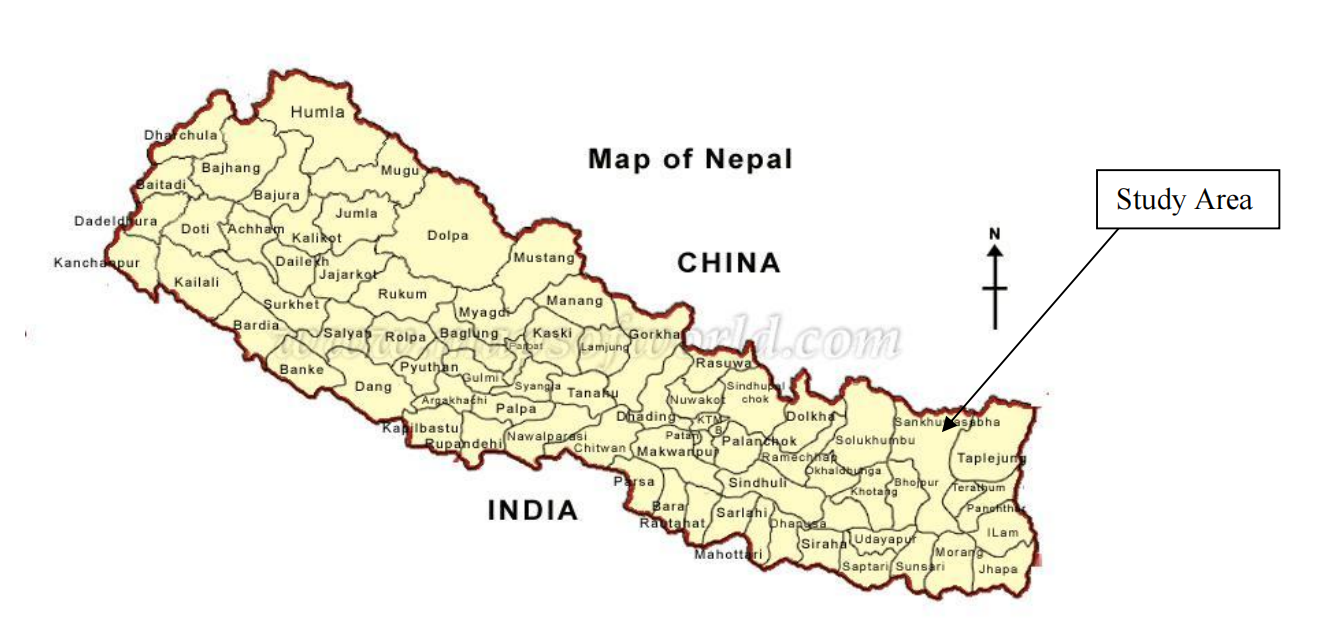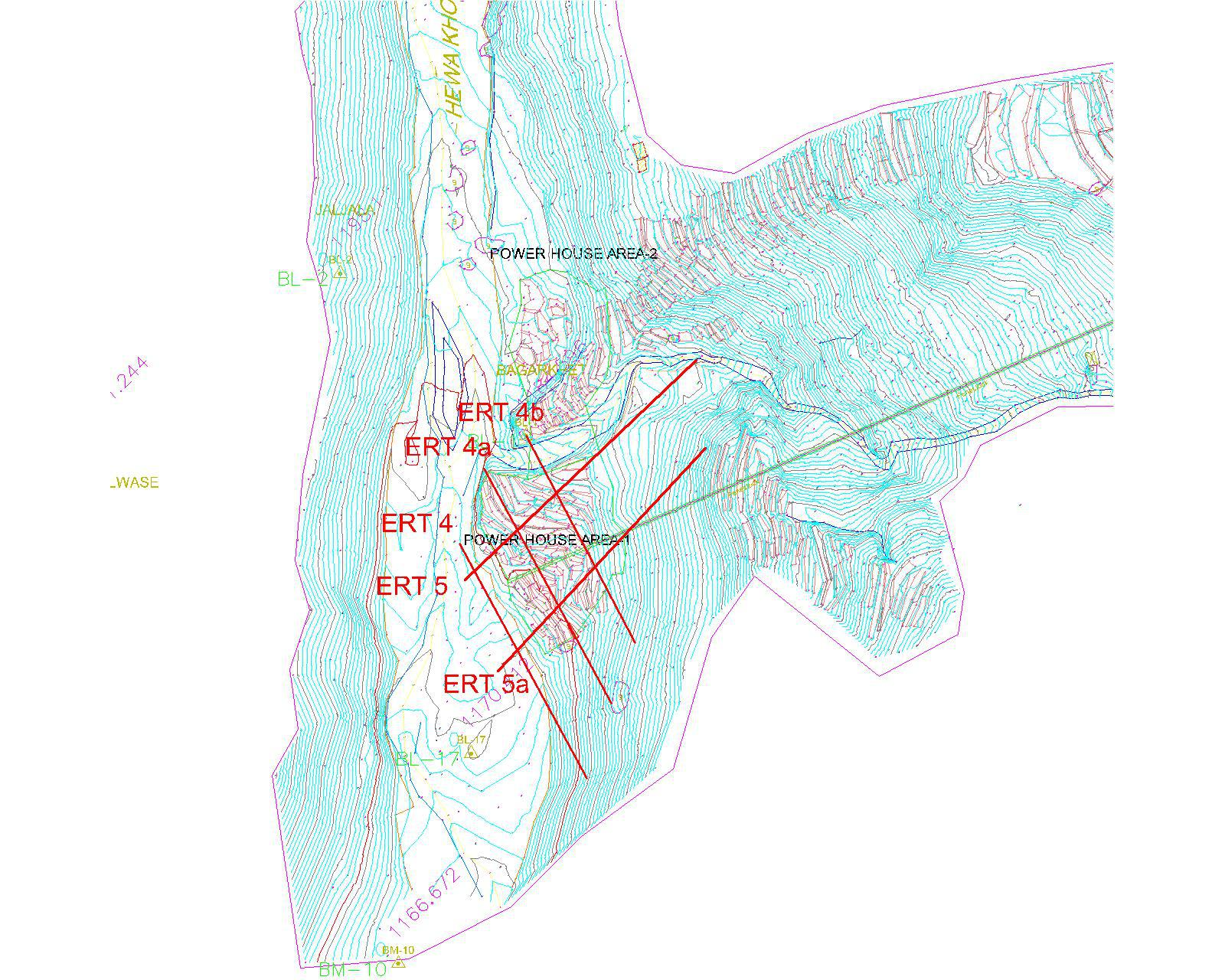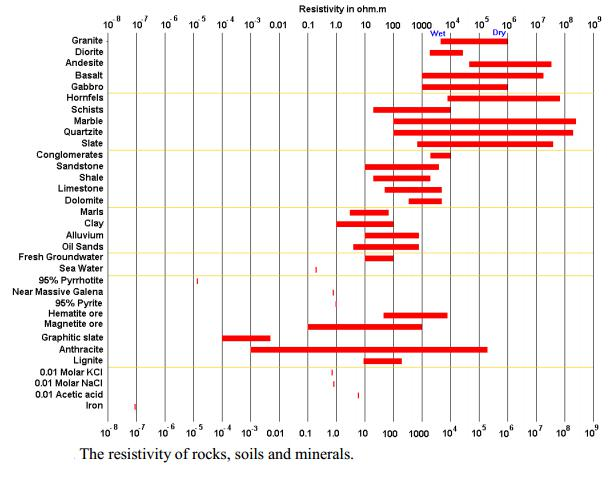
Super Hewa Khola hydroelectric project is located at Super Hewa Khola in Sankhuwasabha District, Koshi Zone, Eastern Development Region of Nepal. The location map of the project area is shown in fig 1.
Geophysical exploration using two Dimensional (2D) electrical resistivity tomography (ERT) survey plays a significant role in determining the subsurface resistivity distribution by making measurement on the ground surface. From these measurements, apparent resistivity is recorded during the fieldwork, which is later converted to true resistivity using appropriate computer software. This true resistivity is then converted to subsurface geological condition. The 2D electrical resistivity profiling is capable of detecting boundaries between unconsolidated materials (overburden), rocks, identifying weathered rock from fresh rock and contact between lithology, water table etc.

The main objective of the proposed study is to carry out the Sub-surface investigation of different components of the Super Hewa Hydropower Project. The boundaries between unconsolidated materials and rocks are determined by the variation in electrical resistivity of the subsurface materials. The main objectives of the ERT survey are as the following:
To establish 2D Electrical Resistivity sections of the ground profile showing different layers of overburden and bedrock.
To find out depths of rock and rock mass condition up to the depth of investigation.
To find out weak zones and water bearing zones in the specified survey areas.
To fulfill these objectives of the study, the site area was mapped by 2D ERT profiles.
Table 1: Location and Profiles of 2D ERT Survey, Super Hewa HEP
| Profile No. | Location | Length (m) |
| ERT-1 | Across the river (Dam site) | 120 |
| ERT-2 | Left bank along the river (Dam site) | 120 |
| ERT-2a | Left bank along the river at settling basin | 120 |
| ERT-3 | Right bank along the river (Dam Site) | 120 |
| ERT-3a | Right bank along the river (Dam Site) | 120 |
| ERT-4 | Left bank along the river (Powerhouse Site) | 120 |
| ERT-4a | Left bank along the river (Powerhouse Site, Up slope from 4a) | 120 |
| ERT-4b | Left bank along the river (Powerhouse Site, Down slope from 4a) | 120 |
| ERT-5 | Left bank along the river (Powerhouse Site, Down slope) | 120 |
| ERT-5b | Left bank along the river (Powerhouse Site, Down slope) | 120 |
| Total length (m) | 1200 | |
The positions and lengths of the profiles were determined by surface geology and topographic map and some adjustments were made on the site to cover the required area of investigation.
The depth of investigation depends on the length of the profile and spacing between electrodes. To collect information from the depth of more than 20 m and deeper, a full length of profile is of 120 m is used in with minimum electrode spacing of 5 m. The details of 2D ERT coverage are tabulated in Table 1.
The field work was initiated on 9th November 2016. The crew returned to Kathmandu on 20th November 2016 after completing the data acquisition in the field. However preliminary data processing was done on the site itself by an experienced professional to check the reliability of the acquired data


Figure 2: ERT Profile lines in topographic map
Electrical Resistivity of Rocks
Electrical resistivity of the rocks or sediments depends on the resistivity of the rock mineral matrix and the fluid contained in its pore spaces. Rocks are composed primarily of quartz, feldspar and mica or other silicate minerals, which are poor conductors. They contain water in the pores, which is usually a better conductor. Thus, the resistivity of rocks generally depends on geometry of its pore spaces and the resistivity (or salinity) of its contained fluid. As permeability and porosity decrease, resistivity usually increases, when there is no change in formation fluid. The resistivity also depends upon the age of the rock or sediment as, with age, they become compacted and/or weathered. Compacted rocks show very high resistivity compared to unconsolidated sediments like clays, sands, gravels and so on as there will be less fluid in it. The weathered rock shows low resistivity when there is presence of water in it. Dry rocks or sediments have very high resistivity (of the order of 10,000 to 100,000 Ohm-m), whereas water bearing rocks or saturated sediments become much less resistant (10 to 1,000 Ohm-m). The resistivity of different rocks and sediments are in Table 2.
All rocks contain some pores in them. Under any reasonable circumstances, these pores are partly or completely filled with water. This water usually carries some salt in solution so that the water content of rock has a far greater capacity for transmitting current than does the solid matrix of the rock unless highly conducting minerals are present.
In some rocks, such as consolidated sedimentary rocks, porosity is inter-granular in nature consisting of the spaces left over after the rock grains were compacted. In other rocks and particularly in igneous rocks, porosity occurs primarily in the form of joints. In general, hard rocks are poor conductors of electricity, but geological processes like weathering, dissolution, hydrothermal alteration; faulting and shearing can alter rock to increase the porosity and permeability of rock and hence decreases resistivity. By comparison, compaction of sedimentary rock and metamorphism of all types may result in lower porositiesand permeability. Resistivity is, therefore, a widely varying parameter, which changes not only from lithology to lithology, but also within a particular formation of same lithology.
Apparent resistivity values obtained in the field are not equal to the actual resistivity of the geologic units which affect the potential measured at the potential electrodes, unless measurements are being made over homogenous ground (Telford and others, 1990). At shallow exploration depth and at short current electrode spacing, shallow layers through which most of the current flows mostly influence measured apparent resistivity. As electrode spacing increases, a greater proportion of the induced current flows into deeper geologic layers, thus the response measured at the surface is reflective of the resistivity of increasingly deeper geologic units as the electrode spacing are increased. Hence as the distance between the current electrodes increases, so does the exploration depth or the depth of investigation of the survey.
Electrical Resistivity versus Lithology

Table 2: Electrical Resistivity versus Lithology
Electrical Resistivity Tomography Survey Design
Electrical Resistivity Tomography survey is usually conducted following the various arrangements of four electrodes, two current (A and B) and two potential (M and N) depending upon the specific purpose (Fig No. 2). the field operation is presented in Photo.

Figure 3: WENNER Electrode Array for profiling
There are many electrode arrangements, which can be used in the ERT field survey. These arrays have advantages and disadvantages. In some geological situations one is particularly better than the other to give better response. To map lateral changes in structures Dipole Dipole and Schlumberger are better. Wenner seems to have a strong signal/noise ratio but smoothes the picture more
The choice of a particular electrode array for the survey in question depends upon many factors. These are summarized below:
Ease in handling:
As mentioned above, gradient and pole-pole arrays are easier to handle. Only two electrodes are to be moved along the profile. Three electrodes are to be moved in Pole-Dipole array and all four electrodes are moved in Wenner, Schlumberger and Dipole-Dipole arrays adding complications in handling more electrodes. But for multi core cables with takeouts at a fixed distance and automatic equipments with switchers, there is no need to move once the cable has been laid out. Our equipment automatically switches between electrodes and data acquisition is possible for 5 m, 10 m, 15 m, 20 m, 25 m, and so on till 95 m of spacing between two electrodes which is almost impossible in manual equipments.
Signal to noise ratio:
In a collinear electrode arrangement, signal to noise ratio or SNR depends on whether the potential electrodes M and N are placed within or outside of the current electrodes A and B. The voltage between M and N and SNR will be higher for the former than for the latter case. In this regard, Wenner array rates higher followed by Schlumberger and Dipole-Dipole arrays. Wenner array has the highest SNR among the conventional arrays. The Pole-Pole, Pole- Dipole and Dipole Dipole arrays are more sensitive to near surface variations. Hence, even in very noisy areas, the Wenner array measurement is the most reliable.
EM coupling:
Frequencies of source signals used in DC resistivity surveying are usually very low (from DC to 50 cycles per seconds) to avoid electromagnetic effects. Most commercial instruments use square waves or pulsed direct currents as source signals. Such signals yield high harmonics, which may result in coupling between the two dipoles and the wires connecting them to the recording instrument. The coupling increases with the frequency, electrode configuration and conductivity of the medium of the flowing current. In this regard, pole-dipole, gradient, Schlumberger and Wenner arrays are progressively more susceptible to coupling. However, the coupling can be reduced taking special care while laying the current and potential cables in the field.
Lateral resolution:
The resolving powers of these arrays are different. It is found that the gradient array has better ability to resolve the steeply dipping inhomogeneity. Coggon, (1973) and Dey et al (1975) establish that Schlumberger array ranks with Wenner array in its lateral resolving power.
Vertical Resolution:
A better vertical resolution helps to demarcate the boundary between different lithology/geology more accurately. The experiment showed that (Loke, M. H. 1999) the vertical resolution is best exhibited by Wenner array. The Dipole Dipole and Wenner- Schlumberger arrays come only after Wenner array.
Anomaly Pattern:
Pole-Dipole is an asymmetrical array and gives rise to somewhat more complicated anomalies in the pseudo section. Signal strength or anomaly strength measured with Pole-Dipole array decrease less rapidly compared to Dipole-Dipole array.
This (Wenner) array is a robust array, which was popularized by the pioneering work carried out by the University of Birmingham research group (Griffiths and Turnbull 1985; Griffiths, Turnbull and Olayinka 1990). Many of the past and present 2D surveys are carried out with this array.
Based on these considerations, it is found that Wenner array has the advantages of i) ease of field operation, ii) high signal to noise ratio, iii) symmetrical array and hence symmetrical anomalies, iv) good lateral resolution, v) good vertical resolution etc. Hence this array method was employed in the present study program. The schematic diagram of this array is shown in Fig No. 2.